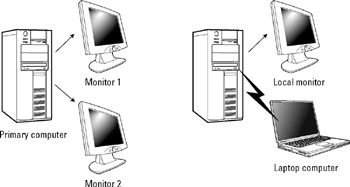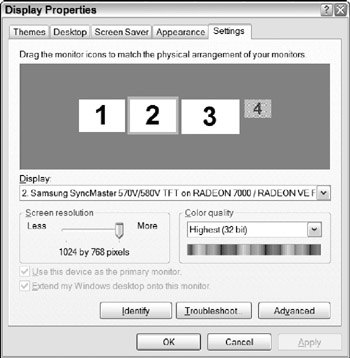Using Multiple Screens through a Network with MaxiVista
MaxiVista is a program that can use the monitor connected to another computer through an Ethernet, IEEE 1394 (FireWire), or wireless network as an additional screen for the primary computer. Instead of using two monitors connected to the same computer, it uses a second computer to provide the second screen. For example, if you have a desktop computer and a laptop, you can use the laptop's screen as a second display for the desktop machine. Figure 28.8 shows the difference between multiple monitors on a single computer and multiple computers using MaxiVista. A free demonstration version of MaxiVista is available from http://www.maxivista.com.

Figure 28.8: Windows can support two or more monitors from a single computer (left); MaxiVista uses the monitor from a second computer as the second screen (right).
If you don't normally use your laptop when working at your desk, or if you have a spare or retired laptop in the back of your storage closet, you can use MaxiVista to convert it to a second monitor screen for your main desktop computer. When you want to take the laptop with you, just turn off MaxiVista, turn off the laptop, disconnect the network cable, and go.
MaxiVista provides several useful services:
-
It allows use of a laptop computer as a second screen for a desktop computer (or another laptop).
-
It allows you to control up to four computers with a single mouse and keyboard.
-
It can send a copy of a computer's screen (and access to the programs, menus, and shortcuts on the screen) to another computer on the same network.
-
It allows you to place text or other data in the Clipboard on one computer and move it to the other computer.
Obviously, there's often a practical limit to the number of monitors you can place on your desk or worktable. If you already have a desktop computer and a laptop, or any other combination of two or more computers in front of you, you might not have enough space for yet another monitor; MaxiVista lets you obtain all the benefits of multiple monitors without adding more hardware.
The MaxiVista package include two separate programs: the Server program that runs on the computer that controls the images on all the screens (the PrimaryPC), and the Viewer program that runs on the computer that provides the added display (the Secondary PC).
When both the Server and Viewer programs are running, Windows treats the computer running the Viewer program as an added monitor on the Server. The same Settings dialog box in the View Properties window controls both multiple monitors and monitors connected through MaxiVista. In fact, if you connect a second computer to a system that already uses multiple monitors, you can use both at the same time, as shown in Figure 28.9. MaxiVista uses exactly the same Display Properties dialog box that Windows uses for other multiple monitor systems.

Figure 28.9: This computer has two monitors (screens 1 and 2) connected directly, plus two more connected through MaxiVista (screens 3 and 4).
In Remote Control mode, MaxiVista doesn't take over the secondary computer's screen. Instead, it allows a user to move the mouse cursor from the primary PC to the secondary PC's desktop, and use the Primary PC's keyboard on programs running on the Secondary PC.
EAN: 2147483647
Pages: 372